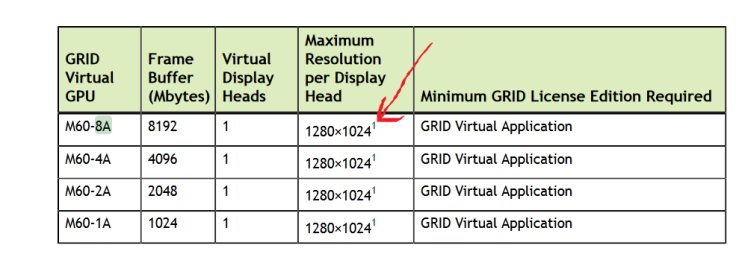I’ve had a few questions about what licensing is needed under the GRID 2.0 and up software licensing for the M60/M10/M6 GPUs for RDSH solutions such as XenApp. I think the confusion arises because it’s possible to use a number of GPU/vGPU different profiles for a server OS VM. The key point is to remember that the licensing is always per user.
Key points:
- GPU-passthrough requires a per user license
- vApps licenses can be used to deliver server OS hosted desktops
- Multi-monitor and resolution support is different to VDI and limited by the virtualisation vendor e.g. VMware/Citrix.“Virtualized applications are rendered in an off-screen buffer. Therefore, the maximumresolution for the A series of GRID vGPUs is independent of the maximum resolution of the display head (of the physical GPU).”
My personal recommendation would be to favour vGPU above pass-through as the GRID 2.0 and up products (inc. M60/M6/M10) benefit from the recently announced monitoring enhancements in the GRID 4.0 (August 2016) software release.
Imagine you want 20 users to connect to a server OS VM shared under RDSH. So 20 user sessions per VM, here are your licensing options. (pGPU = physical GPU).
| Each server OS VM using | Licensing requirements for 20 XenApp users / sessions connecting to that one server OS VM | Quadro features | Monitoring features |
| M60 pGPU on passthrough | 20 vApps
OR 20 vWS |
Yes (only with vWS) | None it’s PCIe technically no host driver |
| M60 vGPU=8Q (vGPU) | 20 vWS | Yes | Yes |
| M60 vGPU=8A (vGPU) | 20 vApps | No | Yes |
As ever the licensing details can be found in the licensing guides on the resources page (under deployment guides) here: http://www.nvidia.com/object/grid-enterprise-resources.html. In particular these two are useful:
- NVIDIA GRID Packaging and Licensing Guide (PDF 1.57 MB)
- GRID Licensing User Guide (PDF 1.6 MB)
Update: to answer Tobias’ questions on resolution / multi-monitor support
If you trawl through the specs of the vGPU profiles in the licensing guides you will spot (or not) a teeny tiny “1” linking to a footnote. This gives the key information that Multi-monitor and resolution support is different to VDI and limited by the virtualisation vendor e.g. VMware/Citrix.“Virtualized applications are rendered in an off-screen buffer. Therefore, the maximumresolution for the A series of GRID vGPUs is independent of the maximum resolution of the display head (of the physical GPU).”


The resolution / multi-monitor support will be determined by the RDSH solution provider e.g. Citrix XenApp (for Citrix you can find info on XenApp monitor and resolution support here: http://support.citrix.com/article/CTX201696. In fact this non-depency of the M60-8A and similar profiles also applies to the M60-8Q and similar when used under XenApp with vGPU to deliver Quadro features e.g. enhanced CAD acceleration (there isn’t a teeny “1” in the licensing guide though). If it’s RDSH the multi-monitor/resolution support is dictated by the virtualisation stack.
The NVIDIA Knowledge Base also carries a lot of useful information on licensing, here: http://nvidia.custhelp.com/app/answers/list/st/5/kw/grid%20licensing/page/1
And you can ask questions on the support forums here: https://gridforums.nvidia.com/

“Quadro feature = No”: Does this imply limits of only one monitor and a resolution only up to 1080 x 1024? By pGPU I take it this means one or more engines in direct hardware passthrough mode.
LikeLike
I’ll go hunting on the monitor / resolution info…
yes pGPU on passthrough
LikeLike
Tobias, yes, almost. See below.
8A:
Max Resolution: 1280×1024
Max Monitor: 1
8Q:
Max Resolution: 4096×2160
Max Monitor: 4
LikeLike
Hi Rasmus – tracked the answer down – it comes down to the physical GPU support actually beign irrelevant in XenApp / RDSH etc…. I’ve updated the article to point out where this is subtly documented…
If you trawl through the specs of the vGPU profiles in the licensing guides you will spot (or not) a teeny tiny “1” linking to a footnote. This gives the key information that Multi-monitor and resolution support is different to VDI and limited by the virtualisation vendor e.g. VMware/Citrix.“Virtualized applications are rendered in an off-screen buffer. Therefore, the maximumresolution for the A series of GRID vGPUs is independent of the maximum resolution of the display head (of the physical GPU).”
LikeLike
In other words, for passthrough in 8A or 8Q mode, the resolution is independent of the display head 1080×1024 value, and depends on the vendor application.
LikeLiked by 1 person
Yes!
LikeLike
Thanks Rachel!
LikeLike
Many thanks, Rachel! 🙂 It’d be even more clear if the resolution limits were incorporated as part of your table at the beginning of the article.
LikeLike
What is the significance of “Virtual display head = 1” for the virtual apps license? I will be publishing Revit in XenApp using the 4a profile. Does this mean the user can only display Revit on 1 monitor…that is it vGPU accelerated on 1 monitor only?
LikeLike